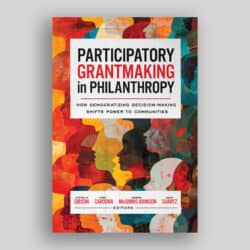By Michael Mears
Published by Voluntary Action Directorate, Multiculturalism and Citizenship
Canada, June 1991
REVIEWED BY GEORGE V. FORSTER
Financial Planning Consultant, Toronto
This 18-page booklet, published by the federal government, is a useful introduction to the role of life insurance in fund raising for charities. Fund raising through life insurance will seldom ease a charity’s immediate needs, but it can be a useful tool for a dedicated donor willing to leave a substantial gift-probably far more than the donor could otherwise give-at some point in the future. Just in case the opportunity is offered to your charity, it’s as well that you understand how complex the process can be and this booklet, abbreviated though it is, should be in every charity’s library.
On the surface, the idea seems simple: a charity takes out a life insurance policy on the life of a donor. The donor pays the premiums and, if the charity is registered, the donor can claim the premiums as a charitable donation. On the donor’s death the insurance proceeds are paid to the charity. As an alternative, a donor can give an existing policy to the charity. In most cases the money for the charity will be significantly more than the amount of premiums paid by the donor.
The author, an Ottawa-based consultant, deals with three kinds of insurance: “term” insurance, “whole life” insurance and “universal life” insurance. He outlines three different ways of making donations and premiums, the tax implications for charities and donors, the consequences of defaulting on the premiums, and the possible effect on the charity’s disbursement quota. There is no reference to the use of annuities as a means of making charitable donations, an omission which may confuse some readers since some charities have existing annuity programs.
A simplified outline such as this booklet introduces a charity to the possibilities of insurance. But both the charity and the donor should remember that life insurance contracts are seldom easy to understand and the charity, the donor, and sometimes the life insurance agent, may have different goals.
If a donor is prepared to pay $500 a year, for example, in life insurance premiums to benefit a charity, what is more vital to the charity’s needs: the death benefit of the insurance policy paid as a lump sum five, 10, 20 or more years in the future or an annual donation of $500 commencing now? Will the death benefit be eroded by inflation before the charity receives it? What will happen to the insurance policy if the charity closes its doors before the death of the donor?
These strategic considerations should be studied in the early stages by both the charity and the donor. And since the marketing of life insurance is fiercely competitive, the charity and the prospective donor should compare carefully the offerings of several different insurance agents, brokers, and companies.
Copies of the booklet can be obtained without charge from the Voluntary Action Directorate, Multiculturalism and Citizenship Canada, Ottawa, K1A OMS. You’ll find it helpful-as long as your expectations are modest.
A New Look at Fundraising for Women’s Services
By Judy Liefschultz, Judy Liefshultz and Associates Fundraising and Business Planning, Victoria B.C.
First published by the Greater Victoria Women’s Shelter Society in 1989. A second edition has been published by the Voluntary Action Directorate, Multiculturalism and Citizenship, Canada, 1990
REVIEWED BY BARBARA GREER
Past Director, Sistering, Toronto
The Shelter Society, an advocacy group, facilitated an innovative fund-raising project in Greater Victoria in 1988 and 1989 involving themselves and five other women’s services agencies. The group’s goals were to develop a forum for discussing women’s services and fund-raising issues, to analyze their present fund-raising effectiveness and to discuss the feasibility of coalition fund raising. This booklet is one result of this co-operative venture.
The first section of the booklet offers an analysis of some typical funding problems faced by women’s services, e.g., women’s historical attitudes towards fund raising (uncomfortable, pessimistic, apologetic); their unwillingness to give fund raising the time and resources it requires; and the lack of a business-like approach. In detailing these handicaps along with some remedies Liefschultz cites the ideological reservations women’s services (e.g., feminist backlash) may encounter from the public and among themselves and the shared weakness that the project members exhibited in creating and understanding budgets, cost analyses and cash flow projections to support fund-raising plans.
The second section consists of five appendices with titles like “Get Ready to Make Money” and “Creating a Fundraising Plan”. Some of these have overlapping instructions so that any organization looking for an all-purpose blueprint will still have to do some work. The material is at a very basic level and will be helpful to organizations in their early years of development. There are some matters not dealt with which such organizations would do well to consider. One is the need to establish early at least a theoretical position regarding legislated provincial and federal funding responsibilities. It may not be possible to get your new service included in an existing government program at the outset but there might be a good case to be made for this happening sooner or later, preferably sooner. This issue raises philosophical questions regarding just who is responsible for responding to service needs-a tough but important question. [See, for example, Evert A. Lindquist, “From Crisis to Opportunity”, (1992), 11 Philanthrop. No. 2, pp. 11-34.] Liefschultz recommends hiring professional fund raisers in some situations but does not give equal attention to the possibility of hiring professional community planners to demonstrate a community need. The project members appeared to have relatively small budgets which may account for their failure to clarify the difference between capital funds and operating funds-a necessity for both good budgeting and good fund-raising practice.
Finally, many funders (foundations, service clubs) have their own forms for funding submissions so it is wise to find out if this is the case before producing an elaborate treatise only to have it returned with the request that the applicant use the form enclosed. There are references to further reading material and some interesting information on the efficacy of publicity and direct mail solicitation. Appendix 6 is an account of coalition fund raising for women’s services in Seattle, Washington. The Victoria group examined the Seattle model which has its own staff, space and eight members who are deriving small amounts of money as yet from their membership but apparently receiving a satisfactory level of less tangible benefits.
The Victoria group felt that they had learned and benefited from working together and would continue to meet and share the costs of technical support, professional services and joint mailings.
A case history of the Innovative Fundraising Project itself would have been valuable-How did it happen? How was it funded? In fact how was the pamphlet itself funded? The source of the funds is given but not the process whereby this occurred.
The pamphlet is available without charge from the Voluntary Action Directorate, Multiculturalism and Citizenship Canada, Ottawa, KIA lKS.


